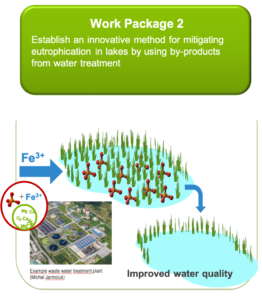WP 2: Novel method for long-term P binding in lake sediments
 Within WP 2 we aim on establishing an innovative method for mitigating eutrophication in lakes by adding Fe-containing by-products from water treatment.
Within WP 2 we aim on establishing an innovative method for mitigating eutrophication in lakes by adding Fe-containing by-products from water treatment.
WP 2 is lead by the University of Bayreuth, and has the following objectives:
i) Characterization of the coupling of Fe and P dynamics in selected lakes
ii) Develop novel method to use Fe-containing by-products of water treatment to improve the quality status of lakes
iii) Evaluation of long-term sustainability of lake restoration based on Fe amendment
To achieve the objectives, WP 2 has several tasks. Each task involves several participants and leads to distinct deliverables and milestones, which have to be reported towards the EC.
Task 1: Determine the coupling of Fe and P dynamics in selected lakes (UU, UBT, EAWAG)
In selected lakes, seasonal dynamics of Fe and P will be investigated in the water column and sediments including ecological characterisation and rigorous characterization of Fe and P speciation.
Task 2: Testing efficiency of adding by-products of water treatment to bind dissolved P in lakes (UU, UBT, GEOS)
Binding of P to by-products of water treatment will be determined.
Task 3: Design procedure for Fe supplementation of the lakes (UU, UBT)
Based on quantitative models timing and dosage of Fe addition in order to achieve long-term trapping of P in sediments will be assessed.
Task 4: Determine potential of Fe addition to lakes for achieving P immobilisation in sediments (UU, UBT, EAWAG)
Effects on nutrient dynamics and ecology upon addition of Fe will be investigated in test sites and in lakes to which Fe has been added in the past.
Deliverables
D2.1 (due month 24, lead UBT, confidential): Reports coupling of Fe and P dynamics in lakes – Report on new insights in the coupling of Fe and P dynamics in lakes
D2.2 (due month 24, lead UU, confidential): Strategy for achieving long-term P burial in lake sediments by Fe addition – Report containing the envisaged strategy to for achieving long-term P burial in lake sediments by Fe addition
D2.3 (due month 32, lead UU, confidential): Report on binding dissolved P by adding Fe-containing by-products – Report on the capability of Fe-containing by-products to bind dissolved P in lakes
D2.4 (due month 40, lead UU, public): Report on long-term effects of Fe addition to lakes – Report or scientific publication on long-term effects of Fe addition to lakes
D2.5 (due month 40, lead UBT, public): Guideline and instructions for using by-products of water treatment for lake restoration – Report guideline and instructions for using by-products of water treatment for lake restoration
Milestones
MS3 (due month 9, lead UU): Selection of suited lakes – Selection finished (report)
MS5 (due month 9, lead KU Leuven): Protocol solid characterisation – A procedure for standard characterisation of Fe and P phases in soils and sediments to be shared by all partners has been established (report)
MS6 (due month 12, lead UBT): Monitoring strategy lakes – A strategy for monitoring the P and Fe dynamics in lakes will be developed including type of sampling, measured parameters, and frequency (report)
MS9 (due month 12, lead UBT): Specification of quantitative models – A framework has been designed which defines the involved processes, the required temporal and spatial resolution of the models (report)
MS12 (due month 18, lead UU): Strategy Fe addition lakes – Based on measurements and model calculations a suitable strategy for adding Fe-containing by-products to lakes has been developed (report)
MS14 (due month 24, lead UBT): Implementation plan lake restoration – The planning for testing the addition of Fe-containing byproducts to improve water quality in lakes has been finalised (report)
MS16 (due month 40, lead UU): Management assessment – Validated management assessment completed (report)
Preliminary results
1st reporting period
A summary of the preliminary results of the first year will be available soon.

